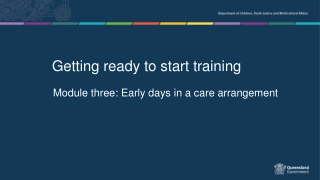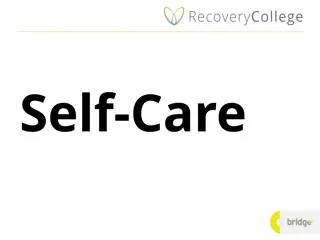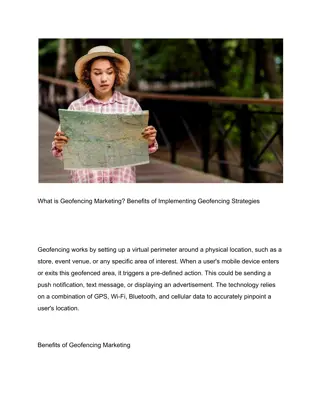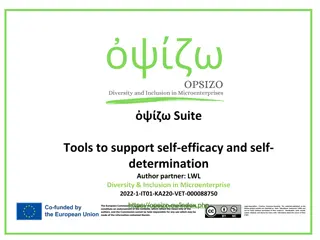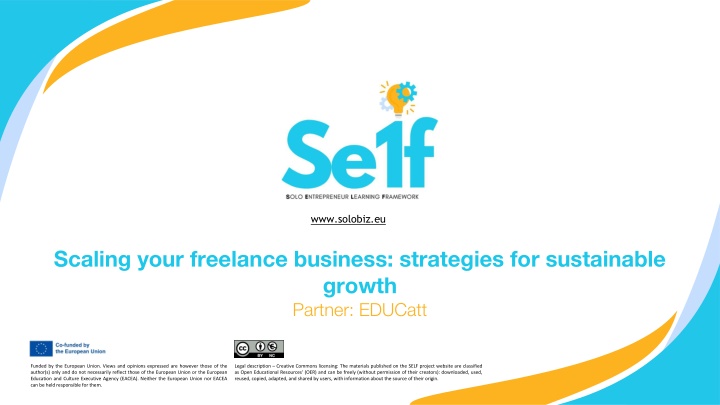
Effective Strategies for Scaling Your Freelance Business
Explore sustainable growth strategies for your freelance business funded by the European Union. Learn to attract new clients, manage workloads efficiently, and diversify your client portfolio. Discover techniques for planning, executing growth, expanding your client base, and scaling operations effectively.
Download Presentation

Please find below an Image/Link to download the presentation.
The content on the website is provided AS IS for your information and personal use only. It may not be sold, licensed, or shared on other websites without obtaining consent from the author. If you encounter any issues during the download, it is possible that the publisher has removed the file from their server.
You are allowed to download the files provided on this website for personal or commercial use, subject to the condition that they are used lawfully. All files are the property of their respective owners.
The content on the website is provided AS IS for your information and personal use only. It may not be sold, licensed, or shared on other websites without obtaining consent from the author.
E N D
Presentation Transcript
www.solobiz.eu www.solobiz.eu Scaling your freelance business: strategies for sustainable growth Partner: EDUCatt Funded by the European Union. Views and opinions expressed are however those of the author(s) only and do not necessarily reflect those of the European Union or the European Education and Culture Executive Agency (EACEA). Neither the European Union nor EACEA can be held responsible for them. Legal description Creative Commons licensing: The materials published on the SELF project website are classified as Open Educational Resources' (OER) and can be freely (without permission of their creators): downloaded, used, reused, copied, adapted, and shared by users, with information about the source of their origin.
Objectives & Goals At the end of this module you will be able to: Understand the steps and key factors for sustainably growing your freelance business. Explore effective strategies for market analysis, strategic planning, and efficient resource management. Learn proven methods for attract new clients and expand your professional network through marketing, referrals, and partnerships. Develop skills to manage increased workloads effectively by leveraging delegation, outsourcing, and process optimization. Master the use of project management tools and systems to streamline operations and manage additional resources efficiently. Recognize the importance of diversifying your client portfolio to minimize dependency on a small group of clients. Funded by the European Union. Views and opinions expressed are however those of the author(s) only and do not necessarily reflect those of the European Union or the European Education and Culture Executive Agency (EACEA). Neither the European Union nor EACEA can be held responsible for them. Legal description Creative Commons licensing: The materials published on the SELF project website are classified as Open Educational Resources' (OER) and can be freely (without permission of their creators): downloaded, used, reused, copied, adapted, and shared by users, with information about the source of their origin.
Index Scaling fundamentals: planning and executing business growth Expanding the client base: attracting and retaining customers Managing growth: techniques for handling increased workload Section1: Introducing the concept of scaling Section 2: Analyzing the current state of things Section 3: Setting clear and measurable goals Section 4: Allocating the right resources effectively Section 5: Conducting a competitor analysis Section 6: Developing a forward-looking growth strategy Section 1: Why expand the client base? Section 2: Marketing strategies and customer engagement Section 3: Leveraging referrals, testimonials, sponsorships and ambassadors Section 4: Diversifying the product or service offering Section 5: Enhancing client retention strategies Section 1: More business, more challenges Section 2: Delegating and outsourcing tasks and activities Section 3: Basics of project management, even for non- project managers Section 4: Scaling operations effectively Funded by the European Union. Views and opinions expressed are however those of the author(s) only and do not necessarily reflect those of the European Union or the European Education and Culture Executive Agency (EACEA). Neither the European Union nor EACEA can be held responsible for them. Legal description Creative Commons licensing: The materials published on the SELF project website are classified as Open Educational Resources' (OER) and can be freely (without permission of their creators): downloaded, used, reused, copied, adapted, and shared by users, with information about the source of their origin.
Unit 1. Scaling fundamentals: planning and executing business growth 1.1 Introducing the concept of scaling Scaling a involves identifying the key steps required for continuous growth and expansion, such as offering new services, acquiring new clients, or entering new markets. In other words, the how to scaling a business requires understanding of the following: Scaling a business implies the ability of the business to grow and expand in a profitable and sustainable manner. Scaling a business involves aligning its operations with long-term visions, adopting a strategic approach to achieve objectives and expected results, and setting it on the right path for growth. 1. The current situation and context variables 1. The desired state, including long-term goals and ambitions The scaling of a business is a systemic and organic process that impacts every aspect and dimension of the organization. 1. The strategies and actions necessary to bridge the gap between the current state and the desired future Funded by the European Union. Views and opinions expressed are however those of the author(s) only and do not necessarily reflect those of the European Union or the European Education and Culture Executive Agency (EACEA). Neither the European Union nor EACEA can be held responsible for them. Legal description Creative Commons licensing: The materials published on the SELF project website are classified as Open Educational Resources' (OER) and can be freely (without permission of their creators): downloaded, used, reused, copied, adapted, and shared by users, with information about the source of their origin.
Unit 1. Scaling fundamentals: planning and executing business growth 1.2 Analysis of current state of things This is the starting point for the development and growth of any business, regardless of its sector, market, size, or the type of goods/services provided. When faced with the challenge of scalability , every (aspiring) entrepreneur must first understand their starting point. Typically, this beings with a thorough assessment of the following (SWOT analysis): 1. STRENGTHS For example, resources available, competences and skills, know- how, and other internal advantages. 2. WEAKNESSES, For example, gaps or deficiencies, and challenges that the business may easily to struggle with. 3. OPPORTUNITIES For example, market trends or external factors that could benefit the business. 4. THREATS, For example, external dynamics or factors that could hinder the smooth operations of the business. By conducting the SWOT analysis, aspiring entrepreneurs can gain a clearer understanding of their business's concrete limitations and growth potential at its current stage, while taking into account the ever-changing scenarios and operational contexts. Funded by the European Union. Views and opinions expressed are however those of the author(s) only and do not necessarily reflect those of the European Union or the European Education and Culture Executive Agency (EACEA). Neither the European Union nor EACEA can be held responsible for them. Legal description Creative Commons licensing: The materials published on the SELF project website are classified as Open Educational Resources' (OER) and can be freely (without permission of their creators): downloaded, used, reused, copied, adapted, and shared by users, with information about the source of their origin.
Unit 1. Scaling fundamentals: planning and executing business growth 1.3 Goals setting Once the key major assumptions are settled, it is time to strategize, understand, and define the long-term goals of development and sustainable growth (including financially). Objectives should be: ambitions and motivating, but not TOO ambitions to the point of being unrealistic. linked to a very specific control parameter so that they can provide measures for their achievement. Both in managerial literature and in practice, it is common knowledge that when thinking about desired objectives, these should be formulated with a SMART approach. practical and enabling the full potential(s) of the business. S = SPECIFIC M = MEASURABLE A = ACHIEVABLE R = RELEVANT T = TIME-BOUNDED correlated to the very mission and vision of the business. Funded by the European Union. Views and opinions expressed are however those of the author(s) only and do not necessarily reflect those of the European Union or the European Education and Culture Executive Agency (EACEA). Neither the European Union nor EACEA can be held responsible for them. Legal description Creative Commons licensing: The materials published on the SELF project website are classified as Open Educational Resources' (OER) and can be freely (without permission of their creators): downloaded, used, reused, copied, adapted, and shared by users, with information about the source of their origin.
Unit 1. Scaling fundamentals: planning and executing business growth 1.4 Allocating the right resources effectively speaking of resources, it is important to point out that at any given stage of business development, entrepreneurs and business owners are required to make strategic decisions about where they want to invest the resources that they have available. In NO order of importance: When talking about the allocation of resources, it is very important to maintain a delicate balance between what is indeed invested in the growth of the business for its future development, and what is needed to keep current operations up and running. Aggressive investments might put under pressure on the operational and financial capacity of the business in the here & now . 1. MONEY economic and financial resources 1. TIME both theirs and that of their collaborators Under-investing might produce the opposite effect, resulting in relatively weak, slow, and flat growth potential. 1. ENERGY focus, commitment, and even physical energy if required by the activity 1. TECHNOLOGY including non-digital or IT-related technology Funded by the European Union. Views and opinions expressed are however those of the author(s) only and do not necessarily reflect those of the European Union or the European Education and Culture Executive Agency (EACEA). Neither the European Union nor EACEA can be held responsible for them. Legal description Creative Commons licensing: The materials published on the SELF project website are classified as Open Educational Resources' (OER) and can be freely (without permission of their creators): downloaded, used, reused, copied, adapted, and shared by users, with information about the source of their origin.
Unit 1. Scaling fundamentals: planning and executing business growth 1.5 Competitors analysis The second most important element of Market Analysis relates to understanding how competitors position their offer in the market and: Competitor analysis gives the businesses the advantage of differentiating and diversifying its own offer, so that it can be appreciated and valued by (potential) customers. what their weakness and strengths are (i.e., what they can do better and what they do very well). It is important to keep in mind that competitors are also business providing services/goods that can be perceived by (potential) customers as valuable substitutes: what the distinctive value of their offer is and how customers react to it. Hot dog vs. hamburger vs. pizza what their costs are and what their correlated pricing strategy is. Cappuccino vs. espresso vs. tea Etc. what sort of opportunities they capitalise on. Funded by the European Union. Views and opinions expressed are however those of the author(s) only and do not necessarily reflect those of the European Union or the European Education and Culture Executive Agency (EACEA). Neither the European Union nor EACEA can be held responsible for them. Legal description Creative Commons licensing: The materials published on the SELF project website are classified as Open Educational Resources' (OER) and can be freely (without permission of their creators): downloaded, used, reused, copied, adapted, and shared by users, with information about the source of their origin.
Unit 1. Scaling fundamentals: planning and executing business growth 1.6 Building a forward-looking growth strategy Three important things should be considered when preparing a strategy for business scaling: A sound, robust, and reliable strategy is very much aware of and considerate toward the importance of short-term results, as these represent the fundamental building blocks for success. 1. The strategy should allow for the growth of the business in a way that is easy to manage, monitor in execution, and evaluate on a regular basis. Short term: per month, or within the semester 1. It should never compromise the well-being of the people, including customers and other key stakeholders. Medium term: within the year, or a two-year period Long term: two years from now and beyond (even 5 or 10 years) 1. It should be motivating, rewarding (also financially), but most importantly, realistic and achievable. These temporal brackets may depend on the scale of the business and the activities conducted. Funded by the European Union. Views and opinions expressed are however those of the author(s) only and do not necessarily reflect those of the European Union or the European Education and Culture Executive Agency (EACEA). Neither the European Union nor EACEA can be held responsible for them. Legal description Creative Commons licensing: The materials published on the SELF project website are classified as Open Educational Resources' (OER) and can be freely (without permission of their creators): downloaded, used, reused, copied, adapted, and shared by users, with information about the source of their origin.
Unit 2. Expanding the client base: attracting and retaining customers 2.1 Why expanding the client base? Acquiring new clients is the fundamental starting point of any growth strategy, regardless the market, industry and sector in which the business operates. In principle: More customers generate more sales As the business grows and expand, it is important that the new acquired customers are happy with the offer provided. More sales generates more revenues More revenues generates more profits More profits generates more investments opportunities This way the business manages to: Reduce the cash-flow dependency from a small group of people. More investments generate more business expansion Capitalise on the word-of-mouth effects that is generated from satisfied customers. More business expansion generate more growth Funded by the European Union. Views and opinions expressed are however those of the author(s) only and do not necessarily reflect those of the European Union or the European Education and Culture Executive Agency (EACEA). Neither the European Union nor EACEA can be held responsible for them. Legal description Creative Commons licensing: The materials published on the SELF project website are classified as Open Educational Resources' (OER) and can be freely (without permission of their creators): downloaded, used, reused, copied, adapted, and shared by users, with information about the source of their origin.
Unit 2. Expanding the client base: attracting and retaining customers 2.2 Marketing and customers engagement Marketing is the fundamental business function to promote the business offer its distinctive values. Traditionally, marketing combines a mix of offline and online strategies. Regardless the media, marketing activities and of the communication message should align with: 1. Profiling of target audience and market segment. 1. Identity of the brand. The expected benefit of any Marketing effort is the effective conveying of the value of the offer provided: utility of the service/good provided adequate price Funded by the European Union. Views and opinions expressed are however those of the author(s) only and do not necessarily reflect those of the European Union or the European Education and Culture Executive Agency (EACEA). Neither the European Union nor EACEA can be held responsible for them. Legal description Creative Commons licensing: The materials published on the SELF project website are classified as Open Educational Resources' (OER) and can be freely (without permission of their creators): downloaded, used, reused, copied, adapted, and shared by users, with information about the source of their origin.
Unit 2. Expanding the client base: attracting and retaining customers 2.3 Referrals, testimonials, sponsorships and ambassadors A satisfied client is normally the most powerful and effective resource to expand the customer base of the business. On the contrary, they can also be source of negative word-of-mouth, and consequently, a powerful threat to the business expansion. Key aspects that business want their customers to valorise and advocate for are linked to: Quality of the service/goods provided, in relation also to price. In the age of internet, people are checking reviews and comments of previous customers before other purchasing decision-making . Effective capacity of the offer to solve the given problem. Overall level of satisfaction with the purchase, including any aspect linked to complementary services (i.e., customer care). It is pivotal for the continuous growth of business to nurture a solid and robust portfolio of positive reviews and feedback: these serve as social proof in building credibility and reliability in potential clients. Value and benefits brought in by the service/goods purchased. Funded by the European Union. Views and opinions expressed are however those of the author(s) only and do not necessarily reflect those of the European Union or the European Education and Culture Executive Agency (EACEA). Neither the European Union nor EACEA can be held responsible for them. Legal description Creative Commons licensing: The materials published on the SELF project website are classified as Open Educational Resources' (OER) and can be freely (without permission of their creators): downloaded, used, reused, copied, adapted, and shared by users, with information about the source of their origin.
Unit 2. Expanding the client base: attracting and retaining customers Section 4: Diversification of the offer One of the traditional way in which business acquires new clients, hence contribute to their sustainable growth, is by diversifying their offer: new products and services addressed to different needs. Examples includes: By diversifying services and products, business can: Meet and accommodate the needs of a wider cohort of people Babysitting + pet sitting Provide more compelling offer Hairstyling + makeup + nail styling Cover a broader market segments Web design + graphic design Limit and contain cash-flow risks Etc. Attract new partners from different fields Funded by the European Union. Views and opinions expressed are however those of the author(s) only and do not necessarily reflect those of the European Union or the European Education and Culture Executive Agency (EACEA). Neither the European Union nor EACEA can be held responsible for them. Legal description Creative Commons licensing: The materials published on the SELF project website are classified as Open Educational Resources' (OER) and can be freely (without permission of their creators): downloaded, used, reused, copied, adapted, and shared by users, with information about the source of their origin.
Unit 2. Expanding the client base: attracting and retaining customers Section 5: Client retention Retaining clients is generally less costly than attracting new ones. Regular check-ins, transparent and open communication, consistency in delivery high-quality service play a pivotal role in client retention. Loyal customers are already familiar with the offer of the business, they know already what to expect from the purchase and they represent a solid base for revenues. Identifying and intercepting any upcoming and latent need strengthens the reputation of the business as a reliable provider of solutions and benefits. The publicity and cash streams they contribute to are fundamental components of the business strategy success. Funded by the European Union. Views and opinions expressed are however those of the author(s) only and do not necessarily reflect those of the European Union or the European Education and Culture Executive Agency (EACEA). Neither the European Union nor EACEA can be held responsible for them. Legal description Creative Commons licensing: The materials published on the SELF project website are classified as Open Educational Resources' (OER) and can be freely (without permission of their creators): downloaded, used, reused, copied, adapted, and shared by users, with information about the source of their origin.
Unit 3. Managing growth: techniques for handling increased workload 3.1 More business, more challenges With the continuous growing of the business, there is also a growing demand of time, energies and resources needed to maintain the momentum and make sure that things go how they are supposed to. The increased workload is most definitely a positive signal: it means that there is in fact new business coming in, new customers are taking notice of the offer, and that more in general, the growth and scalability strategy is working Managing a growing business can become very tricky and complex if his/her owner is not ready to meet the higher demand of work without prejudice the quality of services/goods provided. nonetheless, this implies also new tasks to be processed, more things to keep in check, more resources to be gathered to facilitate and guarantee for the smooth processing of operations. If the business owner is not ready to address and meet the new load of work, it is highly likely that the whole business will suffer of several dysfunctionalities. Funded by the European Union. Views and opinions expressed are however those of the author(s) only and do not necessarily reflect those of the European Union or the European Education and Culture Executive Agency (EACEA). Neither the European Union nor EACEA can be held responsible for them. Legal description Creative Commons licensing: The materials published on the SELF project website are classified as Open Educational Resources' (OER) and can be freely (without permission of their creators): downloaded, used, reused, copied, adapted, and shared by users, with information about the source of their origin.
Unit 3. Managing growth: techniques for handling increased workload 3.2 Delegating and outsourcing tasks and activities First things that new entrepreneurs can do to reduce the workload on their shoulders and manage the increasing demand of efforts is by delegating secondary tasks of their business. The same principle applies also to outsourcing, which is allocating the development of certain task and activities in the hand of external professionals. The business owner retains control over the tasks and activities that are core and strategic to the business, while he/she can contract external professional as well as other small firms to take care of other parts of the business instrumental to keep it operational, e.g.: In the early stage of development, the business owner is typically the sole responsible for everything. As soon as things start evolving for the better, the business owner can start employing new (skilled) people taking under roles and responsibilities specific to certain functions that are in support of the business, e.g.: Web design and graphic Administration Accounting Promotion and communication Funded by the European Union. Views and opinions expressed are however those of the author(s) only and do not necessarily reflect those of the European Union or the European Education and Culture Executive Agency (EACEA). Neither the European Union nor EACEA can be held responsible for them. Legal description Creative Commons licensing: The materials published on the SELF project website are classified as Open Educational Resources' (OER) and can be freely (without permission of their creators): downloaded, used, reused, copied, adapted, and shared by users, with information about the source of their origin.
Unit 3. Managing growth: techniques for handling increased workload 3.3 Basics of project management, even for non-project managers Project management is a fluid business activity that all professionals should be familiar with, at least in its basic components and principles. Trello Asana Jira In its purest form, pursing the growth and sustainability strategy of the business is a project in itself Monday.com Basecamp Nowadays, many project management tools are available online, facilitating the understanding and application of this sophisticated discipline even for those not into the technicalities. Examples include: ClickUp Wrike Microsoft Project Smartsheet Teamwork Funded by the European Union. Views and opinions expressed are however those of the author(s) only and do not necessarily reflect those of the European Union or the European Education and Culture Executive Agency (EACEA). Neither the European Union nor EACEA can be held responsible for them. Legal description Creative Commons licensing: The materials published on the SELF project website are classified as Open Educational Resources' (OER) and can be freely (without permission of their creators): downloaded, used, reused, copied, adapted, and shared by users, with information about the source of their origin.
Unit 3. Managing growth: techniques for handling increased workload 3.4 Scaling the operations, again Now that the business is growing, it is important to reconsider the starting state based on these new assumptions and evaluate, wheatear: At this stage of business development, entrepreneurs should perform a thorough re-analysis of the strategy the lead them there, and see if the initial conditions still apply: new opportunities have emerged Is there a need for additional support staff? new threats are on the rise Are new investments to be made? new strengths have been consolidated Is there a need to integrate new technologies? Should the offer be revitalised with new goods and services? new weaknesses have been discovered Funded by the European Union. Views and opinions expressed are however those of the author(s) only and do not necessarily reflect those of the European Union or the European Education and Culture Executive Agency (EACEA). Neither the European Union nor EACEA can be held responsible for them. Legal description Creative Commons licensing: The materials published on the SELF project website are classified as Open Educational Resources' (OER) and can be freely (without permission of their creators): downloaded, used, reused, copied, adapted, and shared by users, with information about the source of their origin.
Summing up Scaling fundamentals: planning and executing business growth Expanding the client base: attracting and retaining customers Managing growth: techniques for handling increased workload In the first unit, we deep dived into the very fundamentals business scaling , and intended as the organic growth and expansion of the business. In the second unit, we deep dived into one of the most crucial elements leading a business to expand and growth. In the third unit, we explored how business can support and fuel their growth while managing the scaling process. SWOT analysis, goals settings, strategy planning and resource allocation are key fundamental components to operate in every industry and market, regardless of how big it is the scale of activities. By focusing on attracting new clients, nurturing customers loyalty, networking and partnering with other reliable professionals, businesses are capable of generating new revenue streams and sustain their systemic expansion. Managing business growth is challenging and requires continuous monitoring, evaluation and fine-tuning efforts to keep things manageable and in order. Market and competitors analysis complement the picture. Funded by the European Union. Views and opinions expressed are however those of the author(s) only and do not necessarily reflect those of the European Union or the European Education and Culture Executive Agency (EACEA). Neither the European Union nor EACEA can be held responsible for them. Legal description Creative Commons licensing: The materials published on the SELF project website are classified as Open Educational Resources' (OER) and can be freely (without permission of their creators): downloaded, used, reused, copied, adapted, and shared by users, with information about the source of their origin.
www.solobiz.eu www.solobiz.eu Thank you! Funded by the European Union. Views and opinions expressed are however those of the author(s) only and do not necessarily reflect those of the European Union or the European Education and Culture Executive Agency (EACEA). Neither the European Union nor EACEA can be held responsible for them. Legal description Creative Commons licensing: The materials published on the SELF project website are classified as Open Educational Resources' (OER) and can be freely (without permission of their creators): downloaded, used, reused, copied, adapted, and shared by users, with information about the source of their origin.


